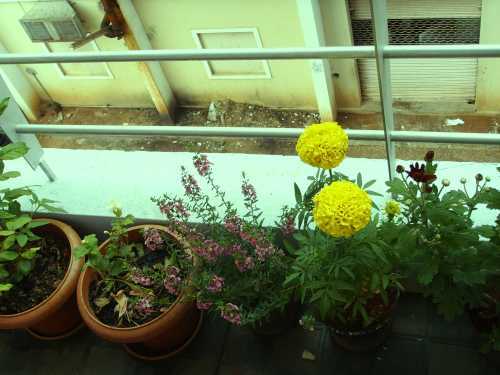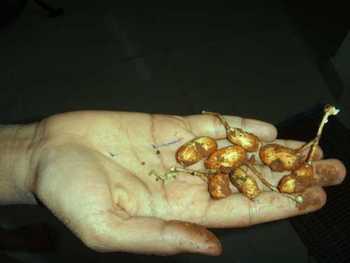I hate to wake up on winter and rainy mornings. Bangalore weather is so perfect that the comfort of the bed is impossible to leave; only the strong aroma of filter coffee can shake me awake.
Over the past two weeks, however, I have found newer reasons to spring out of bed – ever-surprising plants! With the monsoon rains, my 15 feet by 3 feet balcony has transformed into a live garden, blooming with flowers and tons of leafy vegetables (kadipata, kothmir, dhantu, chukaku, palak), chillies, beans, ridge gourds, bitter gourds and so on.
Plucking fresh vegetables and leaves right off the plant, when you set the lunch menu and the cooker is a beautiful experience. The fact that these have been grown with home-made organic manure makes the meal even more healthy and nutritious.

Vegetables from the garden.
pic: Divya Ravindranath
Apart from the food bit, this tiny stretch of my garden offers myriad lessons on nature. By merely observing the potted plants carefully, over many weeks, I have begun to understand seed germination patterns and time-lines, water and sunlight requirements of different plants, bugs (the good and bad ones for plants) and of course the essential earthworms’ lives. And in order to save my plants from any kind of deficiencies or worm attacks, I have begun to experiment on manure, tonics and sprays.
In all, I have realized that almost any sterile looking place can be transformed into a happy one. It only requires a kickstart, some love for plants, working with hands, and of course a garbage-reducing manure pit.
To help you get started here are a few tips:
1) Manure pit: I learnt this long ago in a workshop, and have been using it for over five years very successfully in my home gardens. This is called BBC — Bricks, Bagasse and Compost. It’s very simple, hassle free way of creating strong organic manure. Step one is to get an empty container. It could be an old bucket, or anything else about that size. Make a couple of holes on the sides and the bottom of the container to let excess water seep off.
Step two requires a layer of red brick. Break the brick into many pieces and lay it at the bottom. Sprinkle some water.
Step three is a layer of bagasse (the residue of sugarcane once the juice is taken off). Place bagasse on top on the brick pieces. Sprinkle water again. The last step is a fistful of compost to get the process started. That’s it. The pit is ready. Each day, as you cut your vegetables and fruits put the peels in the pit. In 45 days your first harvest is ready. Dry the compost and use the powdery substance on your plants. Watch your plants shoot up with this booster. This pit attracts only fruit flies and is easy to handle in all weathers. It’s almost odourless and can be kept in any corner.

Flowers in the balcony.
pic: Divya Ravindranath
2) Potting plants: If you are buying plants from a nursery like the one in Lalbagh, most plants will already be potted. But if you are planning to use seeds, you will have to ready the pot as well. It’s fairly simple. First buy the pots of the desired shape (round, square, rectangle), ensure it has a few holes at the bottom for draining of excess water. Next, you will need mud. The sad part about living in a city is that you might have to buy mud as its scarce thanks to most areas cemented. You can find it at any local nursery. Once you have the mud, try and segregate this into different sections– granular, lumpy bits, fine free-flowing mud and so on. Don’t get hassled with this, the segregation doesn’t have to be perfect. At the bottom put a layer of stones or difficult to break grains of mud. Divide the rest of your pot into three parts. Part one will have all the larger grained mud. Next is finer mud. The seed or the plant you plan to use needs to be placed here. Put fine mud on top of it and around. Sprinkle some water. Most seeds germinate within 4-7 days. Then on, watch the miracle, as sun, water and mud give birth to a beautiful plant.

Home grown groundnuts.
pic: Divya Ravindranath
3) De-bugging: Most plants get affected by mealy bugs, especially if there isn’t enough sunlight. These bugs invite black ants, and are quite quick to spread to all other plants. The best solution is to move the plant in sunlight. Make your own spray with two spoons of neem oil in 250 ml of water. After you spray this, the white sticky bugs just fall apart and powder down. You can get this neem oil in any nursery; even malls stack it these days. There are number of other powders, oils that are available in the market. Use trial and error method to see what suits your plant the best.
For potted plants, space can never be a constraint. You can have a few anywhere. There are umpteen varieties in the market to suit shaded and as well as sunny places. Bangalore weather is perfect for fruits, vegetables and flowers.
Growing plants is very therapeutic. Digging, removing weeds and observing plants relieve stress. It’s also a beautiful way to teach children about nature right at home.
⊕
nice to read about your garden divya. i was keen to know more/clarify a few things about the BBC method. what role do the bricks play? (the bagasse holds moisture i guess.)
and how much bagasse would be needed for 1 bucket?
do you need to keep it covered – rain/sun etc?
after adding the day’s waste do we need to add a layer of compost on top to keep away fruit flies.
how long does a bucket (20 litre?) last – in the sense how many days’ worth of waste could i keep adding in 1 bucket? does it last the entire 45 day period?
thanks – i have a terrace and was keen to try this method too.
1)as per a scientist friend of mine bricks and bagasse work as carbon and nitrogen to decompose the waste.
2)you need the residue of about 1 medium sized sugar cane. you can get it easily from any sugarcane juice center. they always give it free of cost. just fold the bagasse to fit into the bucket and place it all around above the bricks
3) dont cover the bucket. during rains all the excess water will get drained out of the holes. it is advisable to keep a plate underneath the bucket so that the water seeping out doesn’t dirty the floor.
in summer sprinkle half a mug of water once in two days. that way the moisture will be maintained.
4) there is absolutely no need for compost on top of each layer. only the first time above bagasse to get the process started. fruit flies are a sign of a healthy pit. they are harmless and speeden the process so please bear with them.
5)one bucket of that size can easily last a month or more. In about 30 days, remove the top layer of the waste. remove everything else from the bottom spread it over a sheet of plastic in the sun. in a couple of days you will have the high-powered concentrated manure.
the top layer that you have removed can be placed back into the bucket. you might need to replace the bagasse as that also decomposes over a period of time!
dont put too much at once on your plants as this very strong and can wither your plants. put little by little over weeks and see your plants bloom
divya
let me know if there are more queries!! happy composting!!
Hello Divya,
Very impressive work. I love my garden and have been experimenting a lot with it. Especially the white bugs on plants. You mentioned neem oil, could you mail where can I get the neem oil. What is the color of neem oil? I got one from nursery was black in color and it spolit my balcony during spray and did not work well on bugs.
Regards,
Avinash
the neem oil i have is brown (almost black) in colour. I got it from a local shop that stocks plastic pots and seeds. i am sure it is not that difficult to find.
You can add a paste of garlic, chillies and ginger to the neem-water mixture. That makes it very pungent and difficult for the bugs to handle